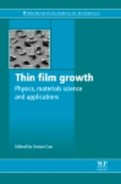Praface
It is well known to researchers who work on thin films that there are currently more than 200 books published that deal with various aspects of thin film science and technology, but this fact does not exclude the necessity for new volumes in this field. None of the existing books has tried to be exhaustive and, more importantly, the field itself keeps marching forward at an elevated pace and in more diversified directions. The latter point is quite understandable since thin films provide the most efficient, flexible and thoughtful uses of solid materials; they offer a uniquely versatile material base for the development of novel technologies. In fact, industries based on the utilization of thin-film devices constitute the strongest driving force for our economy. The attempt to meet the requirements of making more advanced thin-film devices in turn has led to the innovation or invention of deposition techniques and of tools for the characterization of growth processes, and along with this technical progress the understanding of the fundamental physics behind the seemingly endless spectrum of phenomena concerning thin-film growth is also becoming increasingly clear. The publication of a new book on thin-film growth is justified by the fast development of this enterprise alone.
With the current book we intended to summarize the most recent advancements in the field of thin-film growth, focusing on the introduction of new growth and characterization methods, the application-oriented developments and, more importantly, the understanding of the physics relevant to the growth of some particular films, which are at the forefront of thin-film science today. The chapters included in the book aim to present highlights on those topics that have attracted the special attention of the authors and the editor. We hope they can be useful to an interdisciplinary and varied audience including science and engineering graduate students working on thin films, researchers and working professionals who want to have an overview of the field in the recent years or have a strong interest in the new growth and characterization techniques.
The book contains 16 chapters grouped into two parts. Part I comprises five contributions introducing the theory of thin-film growth, including measuring nucleation and growth processes in thin films (Homma), quantum electronic stability of atomically uniform films (Miller and Chiang), phasefield modelling of thin film growth (Voigt), analysis of surface roughness evolution (Kajikawa), and modelling of deposition processes based on real-time observation (Kowarik et al.). The 11 chapters in Part II deal with the advancement of techniques for thin-film growth and relevant device fabrication procedures, including silicon nanostructured films grown on templated surfaces by oblique angle deposition (Ye and Lu), study of phase transitions in colloidal crystal thin films (Ramiro-Manzano et al.), growth for thermally unstable noble-metal nitrides by reactive magnetron sputtering (Cao), growth of graphene layers for thin films (Hong and Jeon), epitaxial growth of graphene on single-crystal metal surfaces (Coraux et al.), determination of electronic properties and adsorption behaviour of polar films (Nilius), polarity control and growth on polar substrates (Wang and Yoshikawa), understanding of buckling (Foucher et al.) and controlled buckling of thin films on compliant substrates for stretchable electronics (Song et al.), electrocaloric effect in ferroelectric polymer films (Lu et al.), and network behaviour in thin films and nanostructure growth dynamics (Guclu et al.). From the very beginning we cherished the hope that these chapters can serve as a guide to the advancement of thin-film science and that graduate students and specialists in both academic and industrial institutions may find the book a valuable reference. As editor I gratefully acknowledge the contributing authors of these chapters, who are all renowned experts in the corresponding subfield of thin-film science. I thank them all for having spent considerable time and effort in compiling these high-level contributions.
Lastly, I am profoundly grateful to the editorial staff of Woodhead Publishing, including Dr Cliff Elwell (commissioning editor), Ms Laura Pugh (commissioning editor) and Miss Nell Holden (project editor), for their sustained support during the two-year preparation of this volume.
